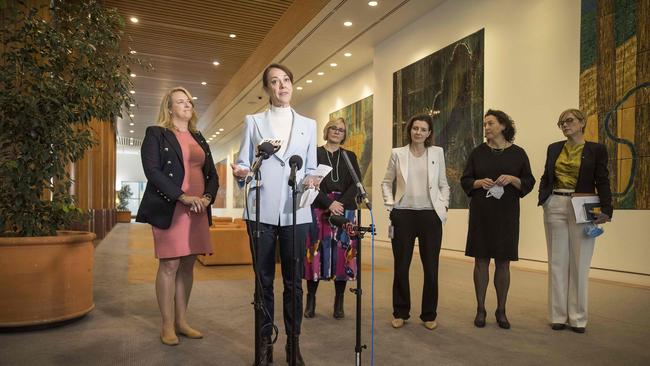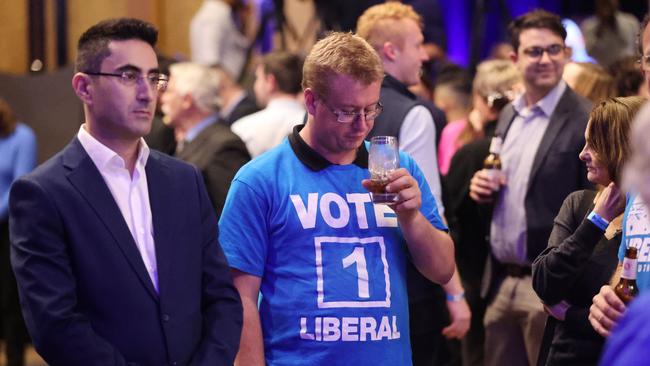Ineffectiveness of Liberal moderates led to rise of the teals
The Coalition’s electoral woes lie in the centre, but Peter Dutton will struggle to win back voters flocking to the independents.

On election night, finance minister Simon Birmingham said Trent Zimmerman, who lost North Sydney, was the victim of a “contagion effect” and was being “punished” for the views of other candidates. Perhaps, but that tends to assume voters didn’t know exactly what they were doing in ousting moderate MPs. Cabinet ministers such as Marise Payne did not speak up enough about the consequences of perpetual culture wars.
Less noticed than moderate MPs losing to the teals were some right-wing MPs losing their seats as well. We also waved goodbye to Eric Abetz in the Senate, not returned from the No.3 position on the Tasmanian ticket.
It is less the numbers balance between the factions as the sheer ineffectiveness of the moderates that led to the rise of the teal independents. The moderates are too quiet internally, too timid externally, and many neglected the community needs of their electorates, increasing their vulnerability when challenged.
Not an uncommon reality in traditionally safe seats. The disdain for Scott Morrison personally in these former Liberal strongholds only exacerbated a problem dating back to the 1970s. Andrew Constance opened up after the election when he said: “The party has been too introverted and too focused on itself,” adding that it needed “broadbased appeal”.
The independent insurgency was part of longer-term changes in politics, most obviously the steady decline in the vote for the major parties since the ’60s. The Labor Party dealing with the rise of the Greens has been much of the focus of this trend. Labor’s declining blue-collar base and the rise of a more educated and affluent middle class is a familiar story.
An important milestone came in 2001 when university-educated voters preferred Labor over the Coalition for the first time. This year, highly educated voters moved from the Coalition to Labor while those who hadn’t finished high school were most likely to stick with the government.
Australian National University professors Ian McAllister and Toni Makkai found occupation, the main determinant of party preference for most of the 20th century, had become unimportant to party identification voting.
The leftward march of the Australian Democrats obscures the fact they were a breakaway group from the Liberal Party in the ’70s. However, the Democrats never enjoyed success in the lower house. The Greens of course are a different beast, but they have been forced to acquiesce now that Labor has a leader prepared to hold the line when the Greens ask for concessions to pass legislation, leaving them with nothing if they stand on principle.
By contrast, challengers to the Liberals and Nationals on the right have been more fragmented. A more populist approach to governing helped keep challengers on the right at bay at the cost of moderate voters in the centre, at one point condescendingly referred to by political strategists as “doctors’ wives”. It hasn’t been obvious until now where these voters could turn if Labor didn’t appeal.

The warning signs were there for the former government beyond the losses in Indi and Warringah. Amid the celebrations of the “miracle” 2019 win, there were swings against the government of between 2 and 5 per cent in North Sydney, Goldstein and Mackellar, while in Kooyong, Josh Frydenberg received a strong challenge from lawyer Julian Burnside representing the Greens.
These longer-term trends were supercharged by Morrison’s failures on gender politics last year. Julie Bishop was prepared to name names when she said: “Women did not see their concerns and interests reflected in a party led by Scott Morrison in coalition with Barnaby Joyce.”
Voters were not convinced the Morrison government was taking climate change seriously despite the final position it took to the election. So much so that in safe seats where voting Labor is a bridge too far for many, they turned to the teals. Seats won by independents can be hard to win back. We know that. Peter Dutton will hardly win over the sorts of voters flocking to the teals. There is an argument that he shouldn’t try – at least not in the short term.
This is separate from the question of the party’s broad church. The Liberal moderate wing is hardly limited to the wealthiest suburbs of Sydney and Melbourne. While the focus on the outer suburban areas didn’t produce any victories for the Coalition at the last election, swings to the Liberals in Lindsay and McEwen make matters more complicated. Hard-headed analysis, not ideology, might lend itself to concentrating on such seats at the next election, with a longer-term strategy to unseat the teals. Similarly, the seats won by the Greens could be hard for both major parties to win back if the Greens don’t radicalise. This will complicate any campaign in Queensland at the next election, which would need to appeal to both progressive and conservative voters.
Contrary to their longstanding political strategy, which was successful throughout the 20th century, Australia’s conservative parties continually promoted their ability to govern in the national interest, whereas Labor represented a sectional interest. On climate change and other issues, it is now the Coalition parties that represent sectional interests. The Greens, long dismissed as a narrow interest group, along with the teals, captured the national interest vote on this issue. Indeed, the teal independents should be recognised as the political expression of a democratic social movement.
Former independent MP Cathy McGowan started out as a cookie-cutter local candidate in Indi seeking to raise local issues, but in forming the Community Independents Network, and successfully passing the baton to Helen Haines, she may have changed Australian politics permanently.
The teal seats could be won back by addressing, on a national basis, the policy issues they have raised – not through local pump-priming or waiting for individuals to retire. It’s not clear the Liberals can do this any time soon, however, or even if they wish to try.
In dealing with this challenge, the Liberals don’t face the mirror image of the contest between Labor and the Greens, where Labor can sit in the middle and tolerate losing some votes to their left. The poor One Nation and United Australia Party performance this year shows the far right remains too fragmented to really challenge the Liberals and Nationals, and these parties will be even less effective with the Coalition no longer in government. The Greens taking two seats from the Liberals, and the teals six, shows the problem for the Coalition lies in the centre.
However, such simple mathematics appears to be beyond some – the some being those left in control of the Coalition rump now consigned to the political wilderness of three years and counting.
Peter van Onselen is a professor of politics and public policy at the University of Western Australia and Griffith University.




As Labor revels in achieving the support it needed to pass its emissions reduction legislation, the Liberal Party needs to engage seriously with why it lost seats to Labor, the Greens and teals.